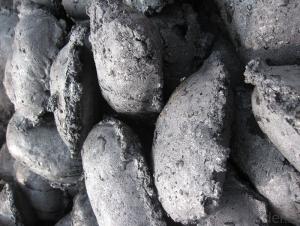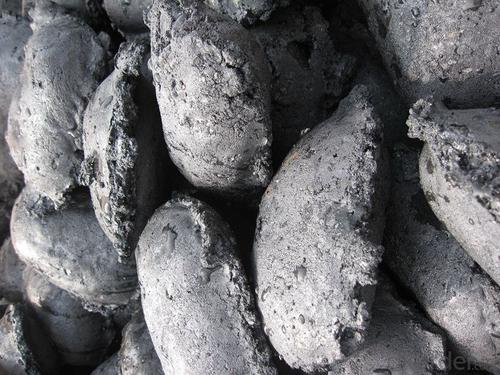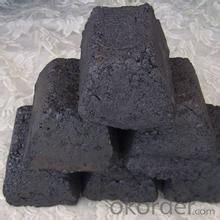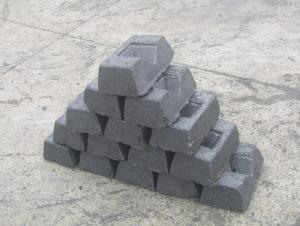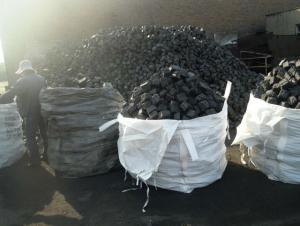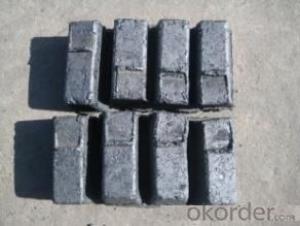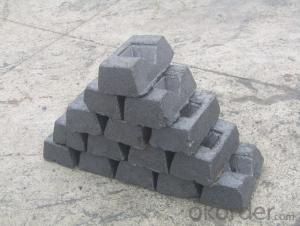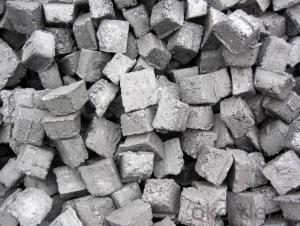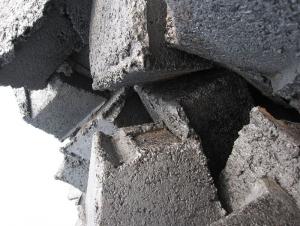Carbon Electrode Paste for felloally production
- Loading Port:
- Lianyungang
- Payment Terms:
- TT OR LC
- Min Order Qty:
- 20 m.t.
- Supply Capability:
- 800 m.t./month
OKorder Service Pledge
OKorder Financial Service
You Might Also Like
Spcifications
1:carbon eletrode paste
2:for ferroalloy,calcium carbide manufacture
3:HS 3801300000,YB/T5212-1996,ISO9001:2008
Product Description
Carbon Electrode Paste is a self-baking electrode used in submerged arc furnaces for delivering power to the charge mix. Electrode Paste is added to the top of the electrode column in either cylindrical or briquette form. As the paste moves down the electrode column the temperature increase causes the paste to melt and subsequently bake forming a block of electrically conductive carbon. Electrode Paste is essentially a mix of Electrically Calcined Anthracite (ECA) or Calcined Petroleum Coke (CPC) with Coal Tar Pitch.
Graphite/Carbon Electrode Paste Specification:
| PARAMETER UNIT GUARANTEE VALUE | ||||||
| Ash.( % ) | 4.0 max | 5.0 max | 6.0 max | 7.0 max | 9.0 max | 11.0 max |
| V.M (%) | 12.0-15.5 | 12.0-15.5 | 12.0-15.5 | 9.5-13.5 | 11.5-15.5 | 11.5-15.5 |
| Compress Strength. | 18.0 min | 17.0 min | 15.7 min | 19.6 min | 19.6 min | 19.6 min |
| Specific Resistance | 65 max | 68 max | 75 max | 80 max | 90 max | 90 max |
| Bulk Density | 1.38 min | 1.38 min | 1.38 min | 1.38 min | 1.38 min | 1.38 min |
Picture:
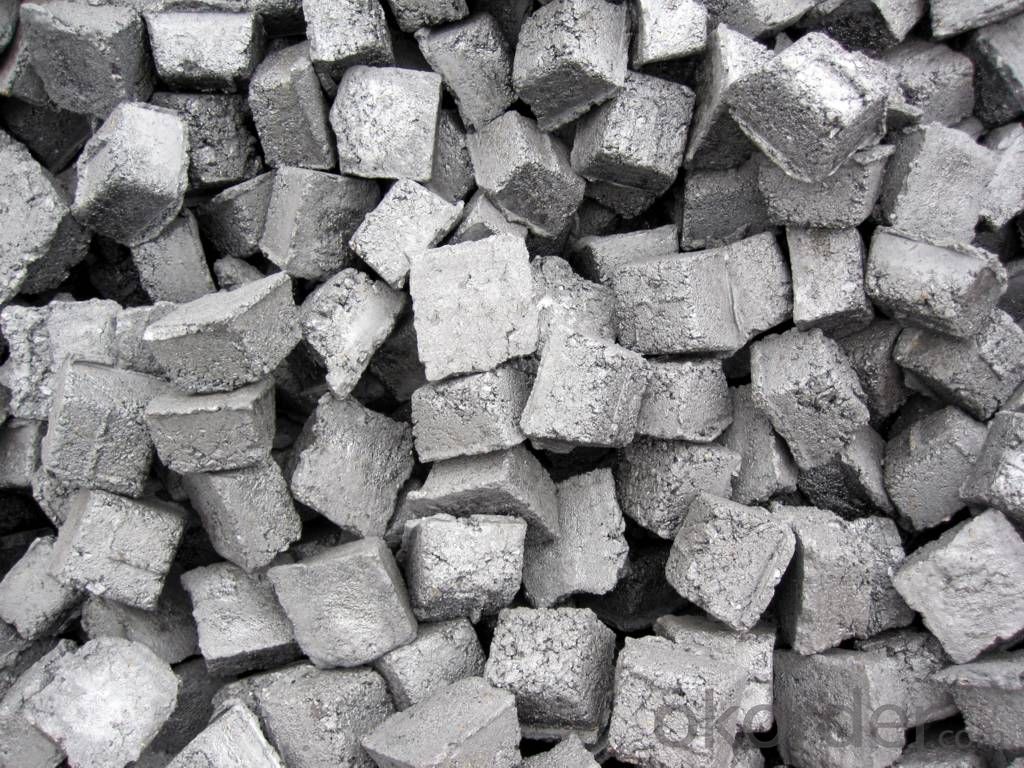
- Q: What are the advantages of carbon-based fertilizers?
- There are several advantages of carbon-based fertilizers that make them a popular choice among farmers and gardeners. Firstly, carbon-based fertilizers such as compost and manure are organic in nature, which means they are derived from natural sources and do not contain synthetic chemicals. This makes them environmentally friendly and reduces the risk of water pollution or soil degradation. Secondly, carbon-based fertilizers are rich in organic matter, which improves the soil structure and enhances its ability to retain water. This can be particularly beneficial in areas with low soil fertility or frequent droughts, as it helps to conserve moisture and prevent nutrient leaching. Furthermore, carbon-based fertilizers promote the growth of beneficial microorganisms in the soil. These microorganisms break down organic matter and release essential nutrients in a slow and gradual manner, ensuring a steady supply of nutrients to the plants. This improves overall plant health and reduces the risk of nutrient imbalances or deficiencies. Additionally, carbon-based fertilizers are cost-effective in the long run. While they may require more initial effort and time to produce or source, they can be produced on-site through composting or obtained from local sources such as farms or livestock operations. This reduces the need for expensive chemical fertilizers and minimizes transportation costs. Lastly, carbon-based fertilizers contribute to carbon sequestration and help combat climate change. By using organic waste materials as fertilizers, we divert them from landfills where they would emit greenhouse gases. Instead, they are recycled back into the soil, increasing its carbon content and promoting soil health. Overall, carbon-based fertilizers offer numerous advantages in terms of sustainability, soil fertility, cost-effectiveness, and environmental impact. Their use can contribute to healthier plants, improved soil quality, and a more sustainable and resilient agricultural system.
- Q: Benefits of reducing carbon emissions
- 1, carbon dioxide in fresh air content of about 0.03%. People living in this space will not be harmed, if the indoor gathered a lot of people, and the air is not circulating. Or indoor gas, liquefied petroleum gas and coal combustion, the oxygen content in the air is relatively reduced, produce large amounts of carbon dioxide, the indoor personnel will appear different degrees of poisoning symptoms. As for the maximum allowable content of carbon dioxide in indoor air, there is no uniform regulation in different countries. Japan has a standard of ventilation when the content of carbon dioxide in the indoor air is 0.15%. The following table shows the effect of CO2 content in air on human body.
- Q: What are the impacts of carbon emissions on the stability of mangroves?
- Carbon emissions have detrimental effects on the stability of mangroves, which are crucial coastal ecosystems. The increased levels of carbon dioxide (CO2) in the atmosphere contribute to global warming, leading to rising sea levels and increased frequency and intensity of storms. These changes directly impact the stability of mangroves in several ways. Firstly, rising sea levels caused by global warming can result in increased inundation of mangroves. As the sea level rises, saltwater intrusion occurs more frequently, affecting the delicate balance of saltwater and freshwater in mangrove ecosystems. This can lead to the displacement and decline of mangroves, as they struggle to adapt to the changing conditions. Secondly, the increased frequency and intensity of storms associated with climate change can cause physical damage to mangroves. Mangroves act as a natural barrier, protecting coastlines from storm surges by absorbing wave energy. However, with stronger storms, the resilience of mangroves is tested, and they may be uprooted or destroyed, leaving the coastlines vulnerable to erosion and further damage. Furthermore, carbon emissions are also linked to ocean acidification, which occurs as the excess CO2 in the atmosphere is absorbed by the oceans. Acidic waters can negatively impact the growth and development of mangroves, as they are sensitive to changes in pH levels. This can lead to reduced productivity, stunted growth, and even death of mangroves, further destabilizing these ecosystems. The stability of mangroves is vital for both the environment and human populations. Mangroves provide essential habitat for various species, serving as a nursery for fish and supporting biodiversity. They also act as carbon sinks, sequestering significant amounts of CO2 from the atmosphere. Additionally, mangroves play a crucial role in coastal protection, mitigating the impacts of erosion, storm surges, and flooding. To mitigate the impacts of carbon emissions on the stability of mangroves, it is crucial to reduce greenhouse gas emissions and limit global warming. This can be achieved through the adoption of clean energy sources, conservation efforts, and reforestation initiatives. Protecting and restoring mangrove habitats is equally important, as it helps maintain their stability and resilience to climate change impacts.
- Q: How does carbon occur in nature?
- Carbon occurs in nature in various forms and is one of the most abundant elements on Earth. It is found in the atmosphere, in the Earth's crust, and in living organisms. In the atmosphere, carbon exists primarily as carbon dioxide (CO2), which is produced through natural processes such as respiration, volcanic activity, and the decay of organic matter. This CO2 is then absorbed by plants during photosynthesis to produce energy and release oxygen. Carbon is also present in other greenhouse gases like methane (CH4), which is produced by natural processes such as the decomposition of organic matter in wetlands and the digestive processes of certain animals. In the Earth's crust, carbon is found in various minerals such as limestone, dolomite, and graphite. These minerals are formed through the deposition and accumulation of marine organisms, such as shells and skeletons of marine organisms, over millions of years. Carbon is also a key component of fossil fuels, including coal, oil, and natural gas, which are formed from the remains of ancient plants and animals buried and subjected to high pressure and temperature over time. Furthermore, carbon is an essential element for all living organisms and is the basis of organic chemistry. It is the key component of all organic matter, including carbohydrates, proteins, lipids, and nucleic acids, which form the building blocks of life. Carbon cycles through various biological processes, such as photosynthesis, respiration, and decomposition, allowing it to be continually recycled within ecosystems. Overall, carbon occurs naturally in the environment in different forms and plays a crucial role in the Earth's climate system, geological processes, and the sustenance of life.
- Q: What are the different types of carbon steel?
- Carbon steel is a versatile and widely used material in various industries due to its strength, durability, and affordability. There are several different types of carbon steel, each with its own unique properties and applications. 1. Low Carbon Steel: This type of carbon steel contains a low amount of carbon, typically up to 0.25%. It is the most commonly used form of carbon steel due to its ease of fabrication, weldability, and affordability. Low carbon steel is used in applications such as construction, automotive manufacturing, and general engineering. 2. Medium Carbon Steel: With a carbon content ranging between 0.25% and 0.60%, medium carbon steel offers increased strength and hardness compared to low carbon steel. It is commonly used in machinery parts, axles, gears, and shafts that require higher levels of toughness and wear resistance. 3. High Carbon Steel: High carbon steel contains a carbon content of 0.60% to 1.00%. It has excellent strength and hardness but is less ductile and more brittle compared to low and medium carbon steels. High carbon steel is commonly used in applications such as cutting tools, springs, and high-strength wires. 4. Ultra-High Carbon Steel: This type of carbon steel contains a carbon content greater than 1.00%, typically ranging from 1.20% to 2.50%. It possesses extremely high hardness and is often used in specialized applications such as knives, blades, and tools that require exceptional sharpness and wear resistance. 5. Carbon Tool Steel: Carbon tool steel refers to a group of steels that contain additional alloying elements such as chromium, vanadium, or tungsten. These alloying elements enhance the steel's hardness, wear resistance, and heat resistance, making it suitable for tool and die making, cutting tools, and molds. It is important to note that the carbon content of steel determines its strength, hardness, and other properties. The choice of carbon steel type depends on the specific application, desired characteristics, and manufacturing requirements.
- Q: What is carbon offsetting in the energy sector?
- Carbon offsetting in the energy sector refers to the practice of balancing out the release of carbon emissions into the atmosphere by investing in projects that reduce or remove an equivalent amount of carbon dioxide from the atmosphere. It aims to neutralize the environmental impact of energy production and consumption by supporting renewable energy projects, reforestation efforts, or other initiatives that reduce greenhouse gas emissions.
- Q: Why are biological molecules carbon based molecular aggregates?
- Because living things are living organisms, most of them consist of organic compounds, which are carbon compounds, and carbon chains are the main body
- Q: What is coal?
- Coal, a sedimentary rock primarily composed of carbon, is black or brownish-black in color and contains various other elements such as hydrogen, sulfur, oxygen, and nitrogen. It forms from the remains of plants that lived and died millions of years ago, accumulating in swampy environments. Over time, the layers of plant material experience high pressure and heat, resulting in coal formation. As one of the most abundant fossil fuels on Earth, coal has been utilized as an energy source for centuries. It is typically extracted from underground or surface mines and exists in different forms, including anthracite, bituminous, sub-bituminous, and lignite, each with varying carbon content and heating value. Due to its high carbon content, coal is primarily employed for electricity generation and fueling industrial processes. When burned, it releases heat energy that is converted into electricity through the utilization of steam turbines. Nevertheless, the combustion of coal also emits greenhouse gases and other pollutants, contributing to air pollution and climate change. Apart from its use as a fuel, coal finds application in the production of steel and cement, as well as various industrial processes. It is a versatile resource that has played a pivotal role in the advancement of modern societies. However, its environmental impact and finite nature have spurred efforts to transition towards cleaner and more sustainable energy sources.
- Q: What is carbon neutral packaging?
- Packaging that is carbon neutral is characterized by having no carbon footprint. This implies that the emissions of carbon dioxide (CO2) released during the production, transportation, and disposal of the packaging are counterbalanced by an equal amount of CO2 being removed from the atmosphere or not emitted in the first place. To achieve carbon neutrality, a range of strategies can be implemented. One commonly used method is to utilize renewable or recycled materials for packaging, such as paper or bioplastics derived from plant-based sources. These materials have a lower carbon footprint compared to traditional petroleum-based plastics. Furthermore, reducing the quantity of packaging used overall and optimizing its design to minimize waste can also contribute to carbon neutrality. Offsetting unavoidable emissions is another crucial aspect of carbon neutral packaging. This can be accomplished by investing in projects that reduce greenhouse gas emissions elsewhere, such as reforestation or renewable energy initiatives. By supporting these projects, the carbon emissions produced by the packaging are counteracted, resulting in no overall impact on the environment. The concept of carbon neutral packaging is gaining traction as businesses and consumers become more cognizant of the environmental consequences of their choices. It offers a means to decrease the carbon footprint associated with packaging, ultimately contributing to a more sustainable and environmentally friendly future.
- Q: What is the role of carbon in organic chemistry?
- Organic chemistry heavily relies on carbon, a fundamental element that plays a crucial role in the structure and function of organic compounds. Its exceptional ability to form stable covalent bonds with both carbon and a wide range of other elements leads to the immense diversity of organic molecules found in nature. Carbon's capacity to bond with itself and other elements allows for the creation of long chains, branched structures, and ring systems, resulting in the complex and distinctive shapes characteristic of organic compounds. In the realm of organic chemistry, carbon acts as the foundation for many vital biomolecules essential for life, such as carbohydrates, lipids, proteins, and nucleic acids. It serves as the basis for the structural variety and intricacy observed in living organisms. Additionally, carbon's ability to form multiple bonds and its tetrahedral geometry contribute to the versatility of organic compounds, enabling the presence of various functional groups like hydroxyl, carbonyl, amino, and carboxyl groups. Moreover, carbon's aptitude for undergoing chemical reactions, including oxidation, reduction, addition, substitution, and elimination reactions, holds significant importance in organic chemistry. These reactions are fundamental for synthesizing and modifying organic compounds, facilitating the creation of new molecules with specific properties and functions. Carbon's central role in organic chemistry extends further to the study of reaction mechanisms, stereochemistry, and comprehending the behavior and reactivity of organic compounds. In summary, carbon's exceptional properties and its capacity to form stable covalent bonds with other elements serve as the cornerstone of organic chemistry. Its presence allows for the vast array of organic compounds that exist, while its participation in chemical reactions enables the synthesis and manipulation of these compounds. Without carbon, the field of organic chemistry and the study of life's fundamental building blocks would be impossible.
Send your message to us
Carbon Electrode Paste for felloally production
- Loading Port:
- Lianyungang
- Payment Terms:
- TT OR LC
- Min Order Qty:
- 20 m.t.
- Supply Capability:
- 800 m.t./month
OKorder Service Pledge
OKorder Financial Service
Similar products
Hot products
Hot Searches
